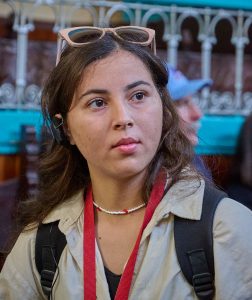 After breakfast (yogurt, crepes with jam, olives, orange juice, and orange and banana slices), we were joined by Fatima, the student we had met a few days before. She had asked Hassan if she could spend a day with us to increase her use of English, and our group was happy to comply.
After breakfast (yogurt, crepes with jam, olives, orange juice, and orange and banana slices), we were joined by Fatima, the student we had met a few days before. She had asked Hassan if she could spend a day with us to increase her use of English, and our group was happy to comply.
The Jewish neighborhood of Fez is called the Mellah. We Americans know that in Fourteen Hundred Ninety-Two, Columbus, an Italian sailing for Spain’s King Ferdinand and Queen Isabella, sailed the ocean 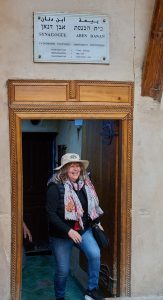 blue and made landfall in the Caribbean. What else of significance happened that year? A decree was issued in Spain that gave Jews and Muslims three choices: convert to Christianity, leave Spain, or face death. Many of Spain’s Jews moved to Morocco. In 1948, a large number of their descendants left Morocco when Israel was created.
blue and made landfall in the Caribbean. What else of significance happened that year? A decree was issued in Spain that gave Jews and Muslims three choices: convert to Christianity, leave Spain, or face death. Many of Spain’s Jews moved to Morocco. In 1948, a large number of their descendants left Morocco when Israel was created.
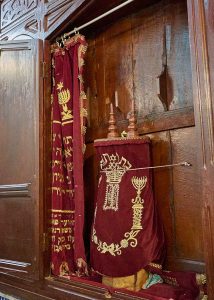 Within the medina, or old town, we visited Synagogue Aben Danan, which originated in the 17th century after 1600 Jewish families moved to Fez. Hassan, wearing a traditional caftan, explained the history of the Jews in Fez to us. The Jewish cemetery was closed, but Nick went up to the roof to see it and get photos.
Within the medina, or old town, we visited Synagogue Aben Danan, which originated in the 17th century after 1600 Jewish families moved to Fez. Hassan, wearing a traditional caftan, explained the history of the Jews in Fez to us. The Jewish cemetery was closed, but Nick went up to the roof to see it and get photos.

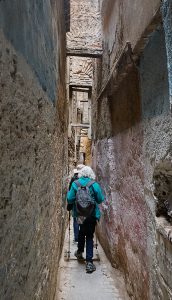
 We headed deeper into to the medina. The medina is filled with souks (shopping areas) displaying a great variety of items for sale including rugs, leather goods, slippers, scarves, jewelry, threads, yarn, fabrics, lamps, clothing and spices. There are lots of produce stalls. We saw a seafood shop near which lots of cats were hoping for nibbles, and a butcher shop that specialized
We headed deeper into to the medina. The medina is filled with souks (shopping areas) displaying a great variety of items for sale including rugs, leather goods, slippers, scarves, jewelry, threads, yarn, fabrics, lamps, clothing and spices. There are lots of produce stalls. We saw a seafood shop near which lots of cats were hoping for nibbles, and a butcher shop that specialized 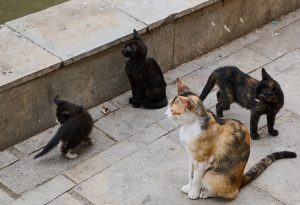 in camel meat. There are also many donkeys, and of course, lots of people, both locals and tourists. The sights, sounds and the aromas were unlike anything that was familiar to us.
in camel meat. There are also many donkeys, and of course, lots of people, both locals and tourists. The sights, sounds and the aromas were unlike anything that was familiar to us.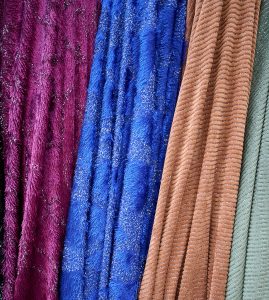
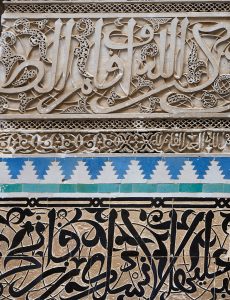
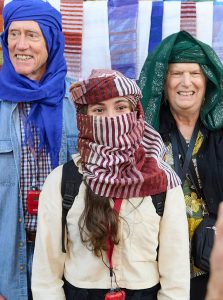
 Inside a weaver’s shop, many members of our group bought scarves that they would wear in the desert to protect themselves from the sun and the sand, including Nick. I had brought a scarf from home with me for that purpose. We stopped at the Nejjarine Museum of Wood Arts and Crafts, which orginally was a stopping place for traders, where ornately carved cedar furniture from past centuries is on display.
Inside a weaver’s shop, many members of our group bought scarves that they would wear in the desert to protect themselves from the sun and the sand, including Nick. I had brought a scarf from home with me for that purpose. We stopped at the Nejjarine Museum of Wood Arts and Crafts, which orginally was a stopping place for traders, where ornately carved cedar furniture from past centuries is on display.
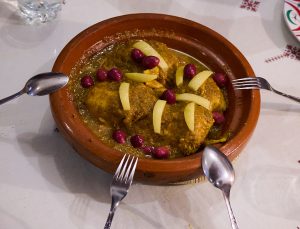 It was time for lunch. Fatima was surprised that we used forks. She tore pieces of bread and used them to pick up the food on her plate. For lunch we had lemon chicken with olives, veggies, bananas, mint tea, and almond cookies.
It was time for lunch. Fatima was surprised that we used forks. She tore pieces of bread and used them to pick up the food on her plate. For lunch we had lemon chicken with olives, veggies, bananas, mint tea, and almond cookies.
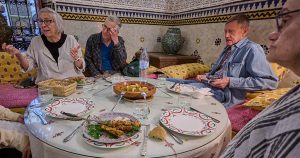 After lunch we visited a tannery at which animal skins, typically camel and goat, were dyed, dried, and made into jackets for men and women as well as handbags, belts, and shoes. The youngest member of our group, Tanner, bought a jacket that fit him perfectly.
After lunch we visited a tannery at which animal skins, typically camel and goat, were dyed, dried, and made into jackets for men and women as well as handbags, belts, and shoes. The youngest member of our group, Tanner, bought a jacket that fit him perfectly.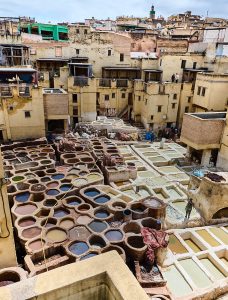
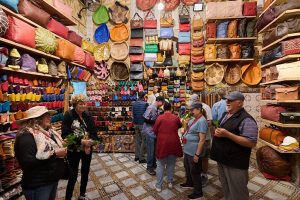
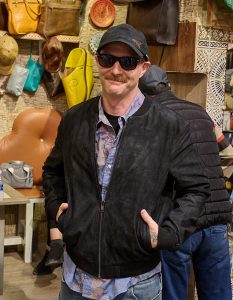
For dinner that night we had an appetizer of lentils, eggplant, zucchini, and carrots. The main course was chicken and other ingredients baked with a crust, or as we would say, chicken pot pie. We were surprised that our savory individual pies had a sweet topping of cinnamon and sugar on the crust.
Fatima thanked us profusely, saying that she would never forget the day she spent with us.
10,571 steps
I loved the medina souks! Truly another cultural world! I remember buying a brass teapot with a half a pack of American cigarettes! I also learned in Spain the Ferdinand and Isabella weren’t the kindly royalty we were taught about in school! They were horrible people who destroyed lives – and Columbus had to beg them for the opportunity to captain those ships! We were woefully misguided by the history taught to us and it didn’t bode well for Catholicism.
Love the pics – looks like a great journey!
Friends who had taken this trip a few months earlier said it was their favorite trip ever, and I can understand that.
Very interesting about the Jewish community. We saw a similar ancient enclave in Catalonia.
Are those vats of dye at the tannery?
Beautiful scarf, Nick!
Yes and pigeon droppings on the right. The droppings make ammonia that softens the leather. It’s all rather fragrant.
It looks so interesting. I hope you are doing some serious shopping.
Love the picture of Nick.